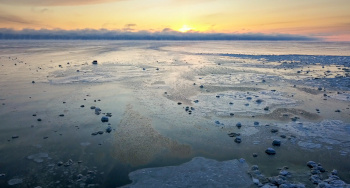Kashechewan, Ontario – On February 21, the Mushkegowuk Council and the Government of Canada announced the successful completion of the feasibility assessment to establish a proposed national marine conservation area (NMCA) in western Weeneebeg (James Bay) and southwestern Washaybeyoh (Hudson Bay). This is a major step toward achieving the official protection of this rich marine environment.
The announcement was made in the community of Kashechewan, Ontario, by Grand Chief Leo Friday of Mushkegowuk Council and Adam van Koeverden, Parliamentary Secretary to the Minister of Environment and Climate Change, on behalf of the Honourable Steven Guilbeault, Minister of Environment and Climate Change and Minister responsible for Parks Canada.
The area has been home to the Omushkego people for millennia, and to a wealth of biodiversity. It contains one of the largest beluga populations in Canada, and a threatened population of polar bears. It is also a global hotspot for breeding and migrating water birds.
Protection of this marine ecosystem helps to conserve biodiversity and assist with climate change mitigation and helps the continuity of the cultures and traditions of Omushkego Cree communities who have long been stewards of these lands and waters. The proposed NMCA would provide for Omushkego people to exercise their rights to decision-making for the future of the area through shared governance with Parks Canada.
Parks Canada and other federal government departments will collaborate to implement interim protection for the proposed NMCA. Parks Canada and the Omushkego people will strive to ensure the proposed national marine conservation area fully supports community members in maintaining and enhancing connections to lands, waters, and ice for the continuity of inherent rights including harvesting.
Engagement and consultation will continue with Indigenous and local communities, other relevant jurisdictions and federal departments, stakeholders, and the public during the next stages toward establishment. The new national marine conservation area, once protected, would also contribute 1.5 per cent to the Government of Canada’s target of protecting 30 per cent of lands and waters in Canada by 2030.
National marine conservation areas are established and managed to protect representative examples of marine regions in Canada for the benefit, education and enjoyment of people living in Canada and around the world. By working in close collaboration with partners, like Mushkegowuk Council, the Government of Canada is committed to halting and reversing biodiversity loss by 2030 and achieving a full recovery for nature by 2050 so it can be enjoyed by all, for generations to come.









